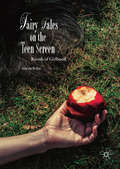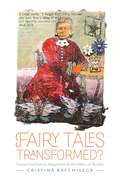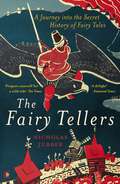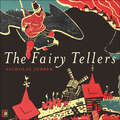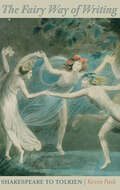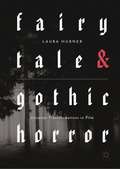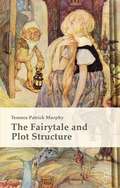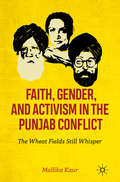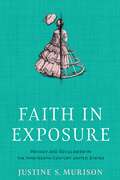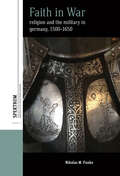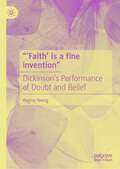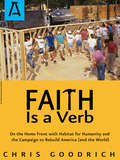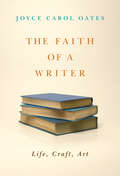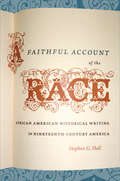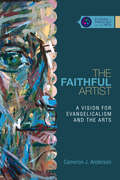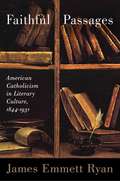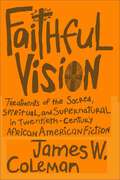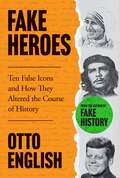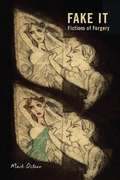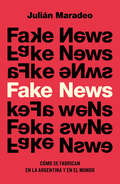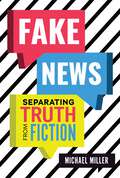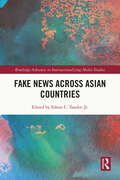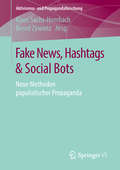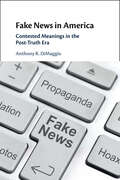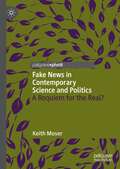- Table View
- List View
Fairy Tales on the Teen Screen
by Athena BellasThis book examines how the fairy tale is currently being redeployed and revised on the contemporary teen screen. The author redeploys Victor Turner's work on liminality for a feminist agenda, providing a new and productive method for thinking about girlhood onscreen. While many studies of teenagehood and teen film briefly invoke Turner's concept, it remains an underdeveloped framework for thinking about youth onscreen. The book's broad scope across teen media--including film, television, and online media--contributes to the need for contemporary analysis and theorisation of our multimedia cultural climate.
Fairy Tales Transformed?: Twenty-First-Century Adaptations and the Politics of Wonder
by Cristina BacchilegaFairy-tale adaptations are ubiquitous in modern popular culture, but readers and scholars alike may take for granted the many voices and traditions folded into today's tales. In Fairy Tales Transformed?: Twenty-First-Century Adaptations and the Politics of Wonder, accomplished fairy-tale scholar Cristina Bacchilega traces what she terms a "fairy-tale web" of multivocal influences in modern adaptations, asking how tales have been changed by and for the early twenty-first century. Dealing mainly with literary and cinematic adaptations for adults and young adults, Bacchilega investigates the linked and yet divergent social projects these fairy tales imagine, their participation and competition in multiple genre and media systems, and their relation to a politics of wonder that contests a naturalized hierarchy of Euro-American literary fairy tale over folktale and other wonder genres. Bacchilega begins by assessing changes in contemporary understandings and adaptations of the Euro-American fairy tale since the 1970s, and introduces the fairy-tale web as a network of reading and writing practices with a long history shaped by forces of gender politics, capitalism, and colonialism. In the chapters that follow, Bacchilega considers a range of texts, from high profile films like Disney's Enchanted, Guillermo del Toro's Pan's Labyrinth, and Catherine Breillat's Bluebeard to literary adaptations like Nalo Hopkinson's Skin Folk, Emma Donoghue's Kissing the Witch, and Bill Willingham's popular comics series, Fables. She looks at the fairy-tale web from a number of approaches, including adaptation as "activist response" in Chapter 1, as remediation within convergence culture in Chapter 2, and a space of genre mixing in Chapter 3. Chapter 4 connects adaptation with issues of translation and stereotyping to discuss mainstream North American adaptations of The Arabian Nights as "media text" in post-9/11 globalized culture. Bacchilega's epilogue invites scholars to intensify their attention to multimedia fairy-tale traditions and the relationship of folk and fairy tales with other cultures' wonder genres. Scholars of fairy-tale studies will enjoy Bacchilega's significant new study of contemporary adaptations.
The Fairy Tellers: A Journey into the Secret History of Fairy Tales
by Nicholas Jubber'Like a child after the Pied Piper I pursued Jubber into a world both human and full of magic. A carnival of a book, rigorously researched and jostling with life' Amy Jeffs, author of Storyland: A New Mythology of Britain'Magical tales about magical tales and tellers. Jubber, congenially and fascinatingly, explores the land from which the great fairy stories seeped, making the stories more resonant, powerful and important than ever' Charles Foster, author of Being a Human and Being a BeastWho were the Fairy Tellers?In this far-ranging quest, award-winning author Nicholas Jubber unearths the lives of the dreamers who made our most beloved fairy tales: inventors, thieves, rebels and forgotten geniuses who gave us classic tales such as 'Cinderella', 'Hansel and Gretel', 'Beauty and the Beast' and 'Baba Yaga'.From the Middle Ages to the birth of modern children's literature, they include a German apothecary's daughter, a Syrian youth running away from a career in the souk and a Russian dissident embroiled in a plot to kill the tsar.Following these and other unlikely protagonists, we travel from the steaming cities of Italy and the Levant, under the dark branches of the Black Forest, deep into the tundra of Siberia and across the snowy fells of Lapland. In the process, we discover a fresh perspective on some of our most frequently told stories. Filled with adventure, tragedy and real-world magic, this bewitching book uncovers the stranger lives behind the strangest of tales.
The Fairy Tellers: A Journey into the Secret History of Fairy Tales
by Nicholas JubberThe surprising origins and people behind the world's most influential magical tales: the people who told and re-shaped them, the landscapes that forged them, and the cultures that formed them and were in turn formed by them.Fairy-Tales are not just fairy-tales: they are records of historical phenomena, telling us something about how Western civilisation was formed. In The Fairy-Tellers' Trail, award-winning travel-writer Nick Jubber explores their secret history of fairy-tales: the people who told them, the landscapes that forged them, and the cultures that formed them. While there are certain names inextricably entwined with the concept of a fairy-tale, such as the Brothers Grimm and Hans Christian Andersen, the most significant tellers are long buried under the more celebrated figures who have taken the credit for their stories - people like the Syrian storyteller Youhenna Diab and the Wild Sisters of Cassel. Without them we would never have heard of Aladdin, his Magic Lamp or the adventures of Hansel and Gretel. Tracking these stories to their sources carries us through the steaming cities of Southern Italy and across the Mediterranean to the dust-clogged alleys of the Maghreb, under the fretting leaves of the Black Forest, deep into the tundra of Siberia and across the snowy hills of Lapland.From North Africa and Siberia, this audiobook illuminates the complicated relationship between Western civilisation and the 'Eastern' cultures it borrowed from, and the strange lives of our long lost fairy-tellers.(P) 2022 Hodder & Stoughton Limited
The Fairy Way of Writing: Shakespeare to Tolkien
by Kevin PaskA history of popular superstitions, tales, and magic in British literature. In The Fairy Way of Writing, Kevin Pask seeks to explain the origins and popularity of enchantment in Shakespeare’s plays. Writers John Dryden and Joseph Addison originated the phrase "fairy way of writing" to define the concept of an English creative imagination founded on a synthesis of high literary culture and the popular culture of tales and superstitions. Beginning with Chaucer, Johnson, Dryden, and Milton, Pask argues that the fairy way of writing not only sets the stage for the fairy tale, the Gothic novel, and children’s literature but also informs genres beyond the English canon, including painting, twentieth-century fantasy fiction, and French fairy tales. In addition to English writers and visual artists such as Pope, Blake, and Keats, who were directly engaged with Shakespearean fantasy, Pask also examines fairy tales, letters, and paintings by the French writers Madame d'Aulnoy, Charles Perrault, Madame de Sévigné, and the Swiss-born artist Johann Heinrich Füssli (Fuseli).The Fairy Way of Writing alters the traditional sense of English literary history and of Shakespeare’s singular place in it, insisting on the importance of often-overlooked literary and visual works. It recovers a distinctive aspect of English literary culture from across the entire early modern era and beyond, one that has been studied in the context of individual periods and writers but is only now explored in relation to the history of European nationalism and the creation of the modern literary system.
Fairytale and Gothic Horror: Uncanny Transformations in Film
by Laura HubnerThis book explores the idiosyncratic effects generated as fairytale and gothic horror join, clash or merge in cinema. Identifying long-held traditions that have inspired this topical phenomenon, the book features close analysis of classical through to contemporary films. It begins by tracing fairytale and gothic origins and evolutions, examining the diverse ways these have been embraced and developed by cinema horror. It moves on to investigate films close up, locating fairytale horror, motifs and themes and a distinctively cinematic gothic horror. At the book’s core are recurring concerns including: the boundaries of the human; rational and irrational forces; fears and dreams; ‘the uncanny’ and transitions between the wilds and civilization. While chronology shapes the book, it is thematically driven, with an interest in the cultural and political functions of fairytale and gothic horror, and the levels of transgression or social conformity at the heart of the films.
Faith, Gender, and Activism in the Punjab Conflict: The Wheat Fields Still Whisper
by Mallika KaurPunjab was the arena of one of the first major armed conflicts of post-colonial India. During its deadliest decade, as many as 250,000 people were killed. This book makes an urgent intervention in the history of the conflict, which to date has been characterized by a fixation on sensational violence—or ignored altogether. Mallika Kaur unearths the stories of three people who found themselves at the center of Punjab’s human rights movement: Baljit Kaur, who armed herself with a video camera to record essential evidence of the conflict; Justice Ajit Singh Bains, who became a beloved “people’s judge”; and Inderjit Singh Jaijee, who returned to Punjab to document abuses even as other elites were fleeing. Together, they are credited with saving countless lives. Braiding oral histories, personal snapshots, and primary documents recovered from at-risk archives, Kaur shows that when entire conflicts are marginalized, we miss essential stories: stories of faith, feminist action, and the power of citizen-activists.
Faith in Exposure: Privacy and Secularism in the Nineteenth-Century United States (Early American Studies)
by Justine S. MurisonRecent legal history in the United States reveals a hardening tendency to treat religious freedom and sexual and reproductive freedom as competing, even opposing, claims on public life. They are united, though, by the fact that both are rooted in our culture’s understanding of privacy. Faith in Exposure shows how, over the course of the nineteenth century, privacy came to encompass such contradictions—both underpinning the right to sexual and reproductive rights but also undermining them in the name of religious freedom.Drawing on the interdisciplinary field of secular studies, Faith in Exposure brings a postsecular orientation to the historical emergence of modern privacy. The book explains this emergence through two interlocking stories. The first examines the legal and cultural connection of religion with the private sphere, showing how privacy became a moral concept that informs how we debate the right to be shielded from state interference, as well as who will be afforded or denied this protection. This conflation of religion with privacy gave rise, the book argues, to a “secular sensibility” that was especially invested in authenticity and the exposure of hypocrisy in others.The second story examines the development of this “secular sensibility” of privacy through nineteenth-century novels. The preoccupation of the novel form with private life, and especially its dependence on revelations of private desire and sexual secrets, made it the perfect vehicle for suggesting that exposure might be synonymous with morality itself. Each chapter places key authors into wider contexts of popular fiction and periodical press debates. From fears over religious infidelity to controversies over what constituted a modern marriage and conspiracy theories about abolitionists, these were the contests, Justine S. Murison argues, that helped privacy emerge as both a sensibility and a right in modern, secular America.
Faith in War: Religion and the Military in Germany, c.1500-1650 (Spektrum: Publications of the German Studies Association #31)
by Nikolas M. FunkeWhile the social and cultural history of the early modern military has greatly advanced in the last few decades, the religious dimension of the military life in the Holy Roman Empire between 1500 and 1650 has hardly been explored. The Reformation brought profound political, social and cultural upheavals, but the religiosity of the men and women who followed the Christian life in the chaos of war still represents a large gap in the historiography. Faith in War shows that confessional antagonisms lost much of their meaning during war and coexistence became a fact of army life. Connecting military and civilian social and cultural history in these ways, Nikolas Funke’s case study on this period brings new life to important current historiographical discussions in a military context, including stereotyping, confessionalization, social discipline, deviance, toleration, religious violence, and the culture of death.
“‘Faith’ is a fine invention”: Dickinson’s Performance of Doubt and Belief
by Regina YoongThis book covers nineteenth-century American poet Emily Dickinson who captured the multifaceted nature of life in all of its uncertainties. Studies on her exploration of faith are ample, but in this book, the author uncovers Dickinson’s playful role-play in enacting solemn themes of religion, death, and the unknown. Dickinson’s creativity encompasses not only her use of language but also her poetic personae and self-created poetic stages inviting readers to question, contemplate deeply or even poke fun at life's absurdities. By using performative roles such as the rejected outcast, passive supplicant, and playful warrior, Dickinson unveils--through a paradoxical framework of belief and unbelief-- a line of inquiry that is multifocal and erratic to “tell all the truth and tell it slant.”
Faith Is a Verb: On the Home Front with Habitat for Humanity and the Campaign to Rebuild America (and the World)
by Chris GoodrichFaith is a Verb is both an account of the author's five years volunteering with Habitat for Humanity and a history of the organization, which Goodrich sees as a model institution founded on grassroots, Jeffersonian principles. The reader looks over his shoulder as Goodrich helps restore a burned-out drug den to its Victorian glory in Bridgeport, Connecticut; understands the yawning gap between the rich and poor as he straightens nails with an impoverished teenager in the Dominican Republic; senses the importance of volunteer work as he watches, while laying a stone foundation in Paraguay, the Twin Towers fall on 9/11.Goodrich traces Habitat's history back to an unsung American hero, Clarence Jordan, who in the 1940's founded a Christian community in Georgia, Koinonia Farm, dedicated to social and economic justice. Millard Fuller, a millionaire businessman, visited at Koinonia in the early 1970's, and under Jordan's guidance realized he was a "money-holic," gave away his fortune, and in 1976 founded Habitat for Humanity. Goodrich shows how Fuller's Southern Baptist, Friday-night-revival personality helped turn Habitat into the world's largest non-governmental home-builder, his inspirational leadership greatly abetted by the support of former president Jimmy Carter. In a postscript the author describes the crisis Habitat faced when Fuller was forced out following allegations of sexual harassment in 2005. This edition updates the story to 2013, when the organization had "helped build or repair more than 600,000 houses" world-wide.What readers have said about Faith is a Verb:"A great record of how [Habitat for Humanity] got underway and became so significant." -- Tony Campolo, PhD., author of Pray Give Go Do"[S]pirited and intimate....Anyone interested in learning about or volunteering for the organization will find his account richly detailed." -- David Bornstein, author of How to Change the World
The Faith of a Writer: Life, Craft, Art
by Joyce Carol OatesA tribute to the brilliant craftsmanship of one of our most distinguished writers, providing valuable insight into her inspiration and her method Joyce Carol Oates is widely regarded as one of America's greatest contemporary literary figures. Having written in a number of genres -- prose, poetry, personal and critical essays, as well as plays -- she is an artist ideally suited to answer essential questions about what makes a story striking, a novel come alive, a writer an artist as well as a craftsman. In The Faith of a Writer, Oates discusses the subjects most important to the narrative craft, touching on topics such as inspiration, memory, self-criticism, and "the unique power of the unconscious." On a more personal note, she speaks of childhood inspirations, offers advice to young writers, and discusses the wildly varying states of mind of a writer at work. Oates also pays homage to those she calls her "significant predecessors" and discusses the importance of reading in the life of a writer. Oates claims, "Inspiration and energy and even genius are rarely enough to make 'art': for prose fiction is also a craft, and craft must be learned, whether by accident or design." In fourteen succinct chapters, The Faith of a Writer provides valuable lessons on how language, ideas, and experience are assembled to create art.
A Faithful Account of The Race
by Stephen G. HallThe civil rights and black power movements expanded popular awareness of the history and culture of African Americans. But, as Stephen Hall observes, African American authors, intellectuals, ministers, and abolitionists had been writing the history of the black experience since the 1800s. With this book, Hall recaptures and reconstructs a rich but largely overlooked tradition of historical writing by African Americans. Hall charts the origins, meanings, methods, evolution, and maturation of African American historical writing from the period of the Early Republic to the twentieth-century professionalization of the larger field of historical study. He demonstrates how these works borrowed from and engaged with ideological and intellectual constructs from mainstream intellectual movements including the Enlightenment, Romanticism, Realism, and Modernism. Hall also explores the creation of discursive spaces that simultaneously reinforced and offered counternarratives to more mainstream historical discourse. He sheds fresh light on the influence of the African diaspora on the development of historical study. In so doing, he provides a holistic portrait of African American history informed by developments within and outside the African American community.
The Faithful Artist: A Vision for Evangelicalism and the Arts (Studies in Theology and the Arts #Coming In August)
by Cameron J. AndersonThe tension between Christianity and the arts is often real. But it also offers a false dichotomy. Many Christian artists think that they must choose between their faith and their artistic calling. Drawing upon his experiences as both a Christian and a practicing artist, Cameron J. Anderson explores the dynamics of faith and art in this latest volume in IVP Academic?s Studies in Theology and the Arts series. Tracing the relationship between evangelicalism and modern art in postwar America—two entities that often found themselves at odds with each other—Anderson raises several issues that confront artists. With skill, sensitivity and insight, he considers questions such as the role of our bodies and our senses in our experience of the arts, the relationship between text and image, the persistent dangers of idolatry, the possibility of pursuing God through an encounter with beauty and more. Throughout this study, Anderson's principal concern is how Christian artists can faithfully pursue their vocational calling in contemporary culture. Readers will find here not only an informed and thoughtful response, but also a vision that offers guidance and hope.
Faithful Passages: American Catholicism in Literary Culture, 1844-1931
by James Emmett RyanRoman Catholic writers in colonial America played only a minority role in debates about religion, politics, morality, national identity, and literary culture. However, the commercial print revolution of the nineteenth century, combined with the arrival of many European Catholic immigrants, provided a vibrant evangelical nexus in which Roman Catholic print discourse would thrive among a tightly knit circle of American writers and readers. James Emmett Ryan's pathbreaking study follows the careers of important nineteenth-century religionists including Orestes Brownson, Isaac Hecker, Anna Hanson Dorsey, and Cardinal James Gibbons, tracing the distinctive literature that they created during the years that non-Catholic writers like Herman Melville and Emily Dickinson were producing iconic works of American literature. Faithful Passagesalso reveals new dimensions in American religious literary culture by moving beyond the antebellum period to consider how the first important cohort of Catholic writers shaped their message for subsequent generations of readers in the late nineteenth and early twentieth centuries. Perhaps most strikingly, Ryan shows that by the early twentieth century, Roman Catholic themes and traditions in American literature would be advanced in complex ways by mainstream, non-Catholic modernist writers like Kate Chopin and Willa Cather. Catholic literary culture in the United States took shape in a myriad of ways and at the hands of diverse participants. The process by which Roman Catholic ideas, themes, and moralities were shared and adapted by writers with highly differentiated beliefs, Ryan contends, illuminates a surprising fluidity of religious commitment and expression in early U. S. literary culture.
Faithful Vision: Treatments of the Sacred, Spiritual, and Supernatural in Twentieth-Century African American Fiction (Southern Literary Studies)
by James W. Coleman"This is a marvelous and sustained discussion of 'faithful vision' and its significant influence on African American literature." -- American LiteratureIn Faithful Vision, James W. Coleman places under his critical lens a wide array of African American novels written during the last half of the twentieth century. In doing so, he demonstrates that religious vision not only informs black literature but also serves as a foundation for black culture generally. The Judeo-Christian tradition, according to Coleman, is the primary component of the African American spiritual perspective, though its syncretism with voodoo/hoodoo -- a religion transported from West Africa through the West Indies and New Orleans to the rest of black America -- also figures largely. Reviewing novels written mainly since 1950 by writers including James Baldwin, Randall Kenan, Toni Morrison, John Edgar Wideman, Alice Walker, Gloria Naylor, Erna Brodber, and Ishmael Reed, among others, Coleman explores how black authors have addressed the relevance of faith, especially as it relates to an oppressive Christian tradition. He shows that their novels -- no matter how critical of the sacred or supernatural, or how skeptical the characters' viewpoints -- ultimately never reject the vision of faith. With its focus on religious experience and tradition and its wider discussion of history, philosophy, gender, and postmodernism, Faithful Vision brings a bold critical dimension to African American literary studies."An insightful interrogation of the complexities of religious discourse in the African American literary tradition. Because it superbly translates complex spiritual ethos into literary tradition, this remarkable book is a must for anyone interested in intersections of the sacred and the secular in black cultural productions." -- Southern Literary Journal"Faithful Vision both looks intently into faith and shows us how to look." -- Christianity and Literature
Fake Heroes: Ten False Icons and How they Altered the Course of History
by Otto EnglishFrom the author of Fake History, Otto English, comes a shocking yet hilarious look at ten of the greatest liars from our past, examining these previously unquestioned idols and exposing what they were trying to hide.'A brilliant book.' James O'BrienWas Che Guevara really a revolutionary hero?Should Mother Teresa be honoured as a saint?Is Henry V actually England's greatest king?And why does JFK's legend continue to grow?Having exposed some of the greatest lies ever told in Fake History, journalist Otto English turns his attention to some of history's biggest (and most beloved) figures.Whether it's virtuous leaders in just wars, martyrs sacrificing all for a cause, or innovators changing the world for the better, down the centuries supposedly great men and women have risen to become household names, saints and heroes. But just how deserving are they of their reputations?Exploring everything from Captain Scott's reckless hunt for glory and Andy Warhol's flagrant thievery to Coco Chanel's murky Nazi past, Otto English dives into the hidden lives of some of history's most recognisable names. Scrutinising figures from the worlds of art, politics, business, religion and royalty, he brings to light the murkier truths they would rather have kept buried away, at the same time as celebrating the unsung heroes lost to time.Fake Heroes exposes the truth of the past and helps us understand why that matters today.
Fake It: Fictions of Forgery
by Mark OsteenHow many layers of artifice can one artwork contain? How does forgery unsettle our notions of originality and creativity? Looking at both the literary and art worlds, Fake It investigates a set of fictional forgeries and hoaxes alongside their real-life inspirations and parallels. Mark Osteen shows how any forgery or hoax is only as good as its authenticating story—and demonstrates how forgeries foster fresh authorial identities while being deeply intertextual and frequently quite original. From fakes of the late eighteenth century, such as Thomas Chatterton’s Rowley poems and the notorious "Shakespearean" documents fabricated by William-Henry Ireland, to hoaxes of the modern period, such as Clifford Irving’s fake autobiography of Howard Hughes, the infamous Ern Malley forgeries, and the audacious authorial masquerades of Percival Everett, Osteen lays bare provocative truths about the conflicts between aesthetic and economic value. In doing so he illuminates the process of artistic creation, which emerges as collaborative and imitative rather than individual and inspired, revealing that authorship is, to some degree, always forged.
Fake news: Cómo se fabrican en la Argentina y en el mundo
by Julián MaradeoA partir de casos locales y del mundo, el libro cuenta la historia de las noticias falsas, de cómo nos ponen en estado de alerta y, al mismo tiempo, refleja la debilidad estatal, la falta de control y el enorme lobby alrededor de ellas. La imagen de una chica con su bebé en brazos mientras carga en la espalda una caja térmica de delivery es la punta del iceberg de un fenómeno que sacudió las nociones de verdad y mentira: las fake news. Todos estamos expuestos y a la vez las reproducimos hasta convertirlas en pandémicas. Sus consecuencias pueden alterar elecciones, decisiones de gobierno e incluso provocar muertes. A partir de casos locales y del mundo, el libro cuenta la historia de las noticias falsas, de cómo nos ponen en estado de alerta y, al mismo tiempo, reflejan la debilidad estatal, la falta de control y el enorme lobby alrededor de ellas. «Esta investigación -dice Julián Maradeo- trata sobre otra forma de ejercer el poder. Una que es imperceptible, escurridiza, placentera y extraterritorial. Una que jaquea a todas las teorías que discurrieron por siglos al respecto. Una en la que interviene un lenguaje que resulta ajeno, sujetos que parecen salidos de una película, geografías remotas. Una que pone en entredicho las reglas del juego democrático. Las noticias falsas no discriminan entre Oriente y Occidente, afectan a todos sin mirar a quién».
Fake News: Separating Truth from Fiction
by Michael MillerWhile popularized by President Donald Trump, the term "fake news" actually originated toward the end of the 19th century, in an era of rampant yellow journalism. Since then, it has come to encompass a broad universe of news stories and marketing strategies ranging from outright lies, propaganda, and conspiracy theories to hoaxes, opinion pieces, and satire—all facilitated and manipulated by social media platforms. This title explores journalistic and fact-checking standards, Constitutional protections, and real-world case studies, helping readers identify the mechanics, perpetrators, motives, and psychology of fake news. A final chapter explores methods for assessing and avoiding the spread of fake news.
Fake News Across Asian Countries (Routledge Advances in Internationalizing Media Studies)
by Edson C. TandocThis book integrates insights from studies conducted across Asia to provide a comprehensive account of the fake news problem in the region.Emerging from a study on how Singapore stakeholders define, determine, and deal with online falsehoods, the volume expands to cover numerous Asian contexts, all of which have experienced the problem in not only similar but also unique ways, coupled with diverse cultures and media regulatory contexts. Drawing from specific examples and case studies to demonstrate the real-world manifestation of the concepts and theories on fake news, the book grounds academic research in lived experiences.This volume will interest journalism scholars and undergraduate and postgraduate students in the areas of media studies, mass communication, digital media, media literacy, Asian studies, and political communication.
Fake News, Hashtags & Social Bots: Neue Methoden populistischer Propaganda (Aktivismus- und Propagandaforschung)
by Klaus Sachs-Hombach Bernd ZywietzDer Band versammelt Beiträge zum Thema der gegenwärtigen „digitalen“ Propaganda, wie sie im Kontext des Populismus eine besondere Rolle spielt. Sie wird als politisch-mediales Phänomen analysiert und als gesellschaftlich-kommunikatives Herausforderung: dies hinsichtlich der Sorge vor der einseitigen Beeinflussung einer neuen, fragmentierten „Masse“ im Netz sowie um die für medienvermittelte Demokratien fundamentale Möglichkeit des vertrauensvollen Austausches von Informationen und Meinungen auf Basis diskursethischer Prinzipien.
Fake News in America: Contested Meanings in the Post-Truth Era
by Anthony R. DiMaggioThe term 'fake news' became a buzzword during Donald Trump's presidency, yet it is a term that means very different things to different people. This pioneering book provides a comprehensive examination of what Americans mean when they talk about fake news in contemporary politics, mass media, and societal discourse, and explores the various factors that contribute to this, such as the power of language, political parties, ideology, media, and socialization. By analysing a range of case studies across war, political corruption, climate change, conspiracy theories, electoral politics, and the Covid-19 pandemic, it demonstrates how fake news is a fundamentally contested phenomenon, and how its meaning varies depending on the person using the term, and the political context. It provides readers with tools to identify, talk about, and resist fake news, and emphasizes a need for education reform with an eye toward promoting critical thinking and information literacy.
Fake News in Contemporary Science and Politics: A Requiem for the Real?
by Keith MoserThis transdisciplinary book investigates the profound repercussions of living in a post-truth world in which 'alternative facts' and post-truth knowledge claims, often bordering on the absurd, have replaced the real in the collective imagination of millions of people around the planet. Through discussions on climate change denial, the anti-vaccination movement, the January 6th Insurrection and the Russia-Ukraine War, this study explores the gravity of the current 'infodemic,' or the increasing inability of a large segment of the population to distinguish between reality and misrepresentation, and the destabilizing impact this infodemic has on democratic models of governance around the globe, coinciding with the rise of autocratic forms of populism.
